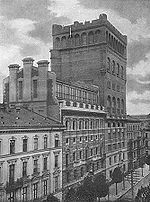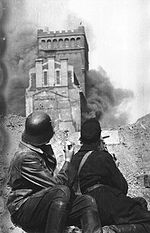
PAST
Encyclopedia


World War I
World War I , which was predominantly called the World War or the Great War from its occurrence until 1939, and the First World War or World War I thereafter, was a major war centred in Europe that began on 28 July 1914 and lasted until 11 November 1918...
and World War II
World War II
World War II, or the Second World War , was a global conflict lasting from 1939 to 1945, involving most of the world's nations—including all of the great powers—eventually forming two opposing military alliances: the Allies and the Axis...
. It is notable for its main headquarters in Warsaw
Warsaw
Warsaw is the capital and largest city of Poland. It is located on the Vistula River, roughly from the Baltic Sea and from the Carpathian Mountains. Its population in 2010 was estimated at 1,716,855 residents with a greater metropolitan area of 2,631,902 residents, making Warsaw the 10th most...
, which at the time of its construction was the first and tallest skyscraper
Skyscraper
A skyscraper is a tall, continuously habitable building of many stories, often designed for office and commercial use. There is no official definition or height above which a building may be classified as a skyscraper...
in the Russian Empire
Russian Empire
The Russian Empire was a state that existed from 1721 until the Russian Revolution of 1917. It was the successor to the Tsardom of Russia and the predecessor of the Soviet Union...
and the tallest building of Warsaw. The fight for the building during the Warsaw Uprising
Warsaw Uprising
The Warsaw Uprising was a major World War II operation by the Polish resistance Home Army , to liberate Warsaw from Nazi Germany. The rebellion was timed to coincide with the Soviet Union's Red Army approaching the eastern suburbs of the city and the retreat of German forces...
of 1944 also added to the legend of the place.
The Swedish-owned company Towarzystwo Akcyjne Telefonów ", also known as Cedergren
Cedergren
Cedergren was a Swedish telecommunications company running the telephone network in Warsaw between 1900 and the interbellum. Named after its founder, Henrik Tore Cedergren, it was notable as the first official phone operator in that city and the company to finance the Cedergren building, the first...
", won a competition in 1900 to expand the Warsaw telephone network. For that purpose, two buildings were built at Zielna street in downtown Warsaw, holding the telephone exchange and the company's headquarters. The building, located at 37 Zielna
Zielna
Zielna is a street in Warsaw city centre, Poland. Initially one of the main streets linking the southern city centre with its northern part, it lost much of its significance in 1941, when the nearby Marszałkowska street had been extended across the Saxon Garden to the Bankowy Sq...
Street, was built between 1904 and 1910 and was constructed in two phases. The lower part, designed by L. Wahlman, I.G. Clason
Isak Gustaf Clason
Isak Gustaf Clason was a Swedish architect.- Biography :Clason studied engineering and later architecture at the Institute of Technology in Stockholm, where he was a student of A. T. Gellerstedt, and later at the architectural school of the Academy of Arts, at the time headed by Fredrik Wilhelm...
and B. Brochowicz-Rogoyski, was completed in 1904-1905; the upper part was added in 1907-1910. The building was one of the first reinforced concrete
Reinforced concrete
Reinforced concrete is concrete in which reinforcement bars , reinforcement grids, plates or fibers have been incorporated to strengthen the concrete in tension. It was invented by French gardener Joseph Monier in 1849 and patented in 1867. The term Ferro Concrete refers only to concrete that is...
constructions of this magnitude in Europe.
The Cedergren license expired in 1922 and the building was consequently taken over by the PAST company. This is why it was referred to by Varsovians either by the name of Cedergren or PAST, or, colloquially, Pasta ( Paste). During the German occupation of Poland, it was the regional telephone center for General Government
General Government
The General Government was an area of Second Republic of Poland under Nazi German rule during World War II; designated as a separate region of the Third Reich between 1939–1945...
. During the Warsaw Uprising
Warsaw Uprising
The Warsaw Uprising was a major World War II operation by the Polish resistance Home Army , to liberate Warsaw from Nazi Germany. The rebellion was timed to coincide with the Soviet Union's Red Army approaching the eastern suburbs of the city and the retreat of German forces...
, on August 20, 1944, the building was captured by Polish insurgents
Insurgency
An insurgency is an armed rebellion against a constituted authority when those taking part in the rebellion are not recognized as belligerents...
of AK battalion „Kiliński” after 20 days of bloody fighting. The building was severely damaged. It was rebuilt in a simplified architectural form after World War II
World War II
World War II, or the Second World War , was a global conflict lasting from 1939 to 1945, involving most of the world's nations—including all of the great powers—eventually forming two opposing military alliances: the Allies and the Axis...
. The company was not recreated after the war and its assets were nationalized by the Polish communist authorities.
External links
- Old and modern pictures of PAST building
- Old and modern pictures of neighbouring building
- 1938 Warsaw telephone directory published by PAST (large .pdf file)
- Skyscrapers of Warsaw - PASTa

